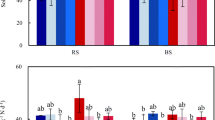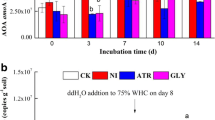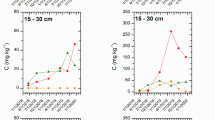Abstract
Ammonium (NH4+) in biogas slurries is readily nitrified into very mobile soil nitrate (NO3−) to promote nitrogen (N) leaching concerning which a few studies, however, have been reported. These slurries are regularly applied through irrigation to purple soil in the Three Gorges Reservoir Area, and therefore we explored the consequent N leaching there with a plot experiment. Biogas slurry irrigation was carried out with nitrogen application rates of 0, 48, 144, 240, 336, and 480 kg N/ha. As a result, the last two rates have triggered N leaching being detrimental to groundwater safety. In addition, N leaching was negatively correlated with soil microbial biomass, diversity, and respiration, indicating a potential technique to prevent it with soil heterotrophs activated by increased ratios of carbon to nitrogen (C/N) in biogas slurries.




Similar content being viewed by others
References
Abubaker J, Risberg K, Pell M (2012) Biogas residues as fertilisers—effects on wheat growth and soil microbial activities. Appl Energy 99:126–134
Abubaker J, Cederlund H, Arthurson V, Pell M (2013) Bacterial community structure and microbial activity in different soils amended with biogas residues and cattle slurry. Appl Soil Ecol 72:171–180
Alburquerque JA, de la Fuente C, Bernal MP (2012) Chemical properties of anaerobic digestates affecting C and N dynamics in amended soils. Agric Ecosyst Environ 160:15–22
Amlinger F, Gotz B, Dreher P, Geszti J, Weissteiner C (2003) Nitrogen in biowaste and yard waste compost: dynamics of mobilisation and availability—a review. Eur J Soil Biol 39:107–116
Amon B, Kryvoruchko V, Amon T, Zechmeister-Boltenstern S (2006) Methane, nitrous oxide and ammonia emissions during storage and after application of dairy cattle slurry and influence of slurry treatment. Agric Ecosyst Environ 112:153–162
Bertora C, Alluvione F, Zavattaro L, van Groenigen JW, Velthof G, Grignani C (2008) Pig slurry treatment modifies slurry composition, N2O, and CO2 emissions after soil incorporation. Soil Biol Biochem 40:1999–2006
Broadbent FE, Clark F (1965) Denitrification. In: Bartholomew WV, Clark FE (eds) Soil nitrogen. American Society of Agronomy, Madison, pp 344–359
Cabrera ML, Beare MH (1993) Alkaline persulfate oxidation for determining Total nitrogen in microbial biomass extracts. Soil Sci Soc Am J 57:1007–1012
Cao H, Tang R, Zhu Q (1983) Normal methods of soil agro-chemical analysis. Beijing, Science Press (in Chinese)
Castillo G, Mena MP, Dibarrart F, Honeyman G (2001) Water quality improvement of treated wastewater by intermittent soil percolation. Water Sci Technol 43:187–190
Chen J, Pan J, Luo L (2008) Study on the pollution of livestock and poultry manure in the Three Gorges Reservoir Area of Chongqing. Agro-Environ Dev 2:100–118 (in Chinese)
Cheng J, Chen Y, He T, Liao R, Liu R, Yi M, Huang L, Yang Z, Fu T, Li X (2017) Soil nitrogen leaching decreases as biogas slurry DOC/N ratio increases. Appl Soil Ecol 111:105–113
China National Evironmental Monitoring Center (CNEMC) (2007) Water quality-determination of nitrate-nitrogen-ultraviolet spectrophotometry. China Environmental Science Press, Beijing (in Chinese)
de la Fuente C, Alburquerque JA, Clemente R, Bernal MP (2012) Soil C and N mineralisation and agricultural value of the products of an anaerobic digestion system. Biol Fertil Soils 49:313–322
Fessehazion MK (2012) Using adaptive management and modelling to improve nitrogen and water use efficiency in crop production : a case study using annual ryegrass, University of Pretoria
Gao S (2017) The Three Gorges Project: development and environmental issues (in Chinese)
Gericke D, Bornemann L, Kage H, Pacholski A (2012) Modelling ammonia losses after field application of biogas slurry in energy crop rotations. Water Air Soil Pollut 223:29–47
Gleick P (2009) Three Gorges Dam Project, Yangtze River, China
Goberna M, Podmirseg SM, Waldhuber S, Knapp BA, García C, Insam H (2011) Pathogenic bacteria and mineral N in soils following the land spreading of biogas digestates and fresh manure. Appl Soil Ecol 49:18–25
Gomez-Brandon M, Juarez MFD, Zangerle M, Insam H (2016) Effects of digestate on soil chemical and microbiological properties: a comparative study with compost and vermicompost. J Hazard Mater 302:267–274
Grigatti M, Di Girolamo G, Chincarini R, Ciavatta C, Barbanti L (2011) Potential nitrogen mineralization, plant utilization efficiency and soil CO2 emissions following the addition of anaerobic digested slurries. Biomass Bioenergy 35:4619–4629
Guan SF, Xia ZY, Zhang LL, Chen Y (2014) Research of compressibility of purple soil in the Three Gorges Reservoir. Adv Mater Res 1010-1012:622–625
Hagedorn F, Schleppi P (2000) Determination of total dissolved nitrogen by persulfate oxidation. J Plant Nutr Soil Sci 163:81–82
Harmsen GW, Kolenbrander GJ (1965) Soil in organic nitrogen. In: Bartholomew WV, Clark FE (eds) Soil nitrogen, Madison, American Society of Agronomy, pp 43–92
Hedström A, Amofah LR (2008) Adsorption and desorption of ammonium by clinoptilolite adsorbent in municipal wastewater treatment systems. J Environ Eng Sci 7:53–61
Huang X, Ye W, Deng W, Cheng B (1999) The significance of and technical measures for a eco-friendly sericulture industry coordinating with the conservation of water and soil in the Three Gorges Reservoir Area. Hubei Agric Sci 9:38–40 (in Chinese)
Huang M, Xia Y, Fan X, Huang M, Wu M, Liu D, Zhang F (2017) Evaluation of livestock pollution status in the Three Gorges Reservoir Area of Hubei Province. Chin J Ecol 36:725–733 (in Chinese)
Insam H, Gomez-Brandon M, Ascher J (2015) Manure-based biogas fermentation residues—friend or foe of soil fertility? Soil Biol Biochem 84:1–14
Jansson SL, Hallam MJ, Bartholomew WV (1955) Preferential utilization of ammonium over nitrate by micro-organisms in the decomposition of oat straw. Plant Soil 6:382–390
Jellali S, Diamantopoulos E, Kallali H, Bennaceur S, Anane M, Jedidi N (2010) Dynamic sorption of ammonium by sandy soil in fixed bed columns: evaluation of equilibrium and non-equilibrium transport processes. J Environ Manag 91:897–905
Johansen A, Carter MS, Jensen ES, Hauggard-Nielsen H, Ambus P (2013) Effects of digestate from anaerobically digested cattle slurry and plant materials on soil microbial community and emission of CO2 and N2O. Appl Soil Ecol 63:36–44
Kangmeznarich JH, Broderick GA (1980) Effects of incremental urea supplementation on ruminal ammonia concentration and bacterial protein-formation. J Anim Sci 51:422–431
Kaye JP, Hart SC (1997) Competition for nitrogen between plants and soil microorganisms. Trends Ecol Evol 12:139–143
Köster JR, Cárdenas L, Senbayram M, Bol R, Well R, Butler M, Mühling KH, Dittert K (2011) Rapid shift from denitrification to nitrification in soil after biogas residue application as indicated by nitrous oxide isotopomers. Soil Biol Biochem 43:1671–1677
Kuzyakov Y, Friedel JK, Stahr K (2000) Review of mechanisms and quantification of priming effects. Soil Biol Biochem 32:1485–1498
Ma X, Li Y, Li B, Han W, Liu D, Liu X (2016) Evaluation of nitrogen and phosphorus loads from agricultural nonpoint source in relation to water quality in Three Gorges Reservoir Area, China. Desalin Water Treat 57:20985–21002
Matsunaka T, Sawamoto T, Ishimura H, Takakura K, Takekawa A (2006) Efficient use of digested cattle slurry from biogas plant with respect to nitrogen recycling in grassland. Int Congr Ser 1293:242–252 (in Chinese)
Ministry of Environment Protection of the People's Republic of China (MEPC) (1987) Water quality-determination of nitrogen (nitrite)—spectrophotometric method. China Environmental Science Press, Beijing (in Chinese)
Ministry of Environment Protection of the People's Republic of China (MEPC) (1990) Water quality-determination of total nitrogen-alkaline potassium persulfate digestion-UV spectrophotometric method. China Environmental Science Press, Beijing (in Chinese)
Ministry of Environment Protection of the People's Republic of China (MEPC) (1994) Quality standard for groundwater. China Environmental Science Press, Beijing (in Chinese)
Ministry of Environment Protection of the People's Republic of China (MEPC) (2009) Water quality-determination of ammonia nitrogen-Nessler’s reagent spectrophotometry. China Environmental Science Press, Beijing (in Chinese)
Ministry of Environment Protection of the People's Republic of China (MEPC) (2012) Soil determination of ammonium, nitrite and nitrate by extraction with potassium chloride solution-spectrophotometric methods. China Environmental Science Press, Beijing (in Chinese)
Möller K, Müller T (2012) Effects of anaerobic digestion on digestate nutrient availability and crop growth: a review. Eng Life Sci 12:242–257
Monaco S, Sacco D, Pelissetti S, Dinuccio E, Balsari P, Rostami M, Grignani C (2011) Laboratory assessment of ammonia emission after soil application of treated and untreated manures. J Agric Sci 150:65–73
Nkoa R (2014) Agricultural benefits and environmental risks of soil fertilization with anaerobic digestates: a review. Agron Sustain Dev 34:473–492
Palmer M (2015) Ordination methods for ecologists, http://ordination.okstate.edu (accessed February, 2018)
Pansu M, Gautheyrou J (2003) Handbook of soil analysis: mineralogical, organic and inorganic methods. Springer-Verlag, Berlin
Quakernack R, Pacholski A, Techow A, Herrmann A, Taube F, Kage H (2012) Ammonia volatilization and yield response of energy crops after fertilization with biogas residues in a coastal marsh of Northern Germany. Agric Ecosyst Environ 160:66–74
Recous S, Mary B, Faurie G (1990) Microbial immobilization of ammonium and nitrate in cultivated soils. Soil Biol Biochem 22:913–922
Ricke SC, Schaefer DM (1991) Growth-inhibition of the rumen bacterium Selenomonas-Ruminantium by ammonium-salts. Appl Microbiol Biotechnol 36:394–399
Sänger A, Geisseler D, Ludwig B (2011) Effects of moisture and temperature on greenhouse gas emissions and C and N leaching losses in soil treated with biogas slurry. Biol Fertil Soils 47:249–259
Sanger A, Geisseler D, Ludwig B (2014) C and N dynamics of a range of biogas slurries as a function of application rate and soil texture: a laboratory experiment. Arch Agron Soil Sci 60:1779–1794
Sawada K, Toyota K (2015) Effects of the application of digestates from wet and dry anaerobic fermentation to Japanese paddy and Upland soils on short-term nitrification. Bull Jpn Soc Microbial Ecol 30:37–43
Senbayram M, Chen R, Muhling KH, Dittert K (2009) Contribution of nitrification and denitrification to nitrous oxide emissions from soils after application of biogas waste and other fertilizers. Rapid Commun Mass Spectrom 23:2489–2498
Svoboda N, Taube F, Kluß C, Wienforth B, Kage H, Ohl S, Hartung E, Herrmann A (2013a) Crop production for biogas and water protection—a trade-off? Agric Ecosyst Environ 177:36–47
Svoboda N, Taube F, Wienforth B, Kluß C, Kage H, Herrmann A (2013b) Nitrogen leaching losses after biogas residue application to maize. Soil Tillage Res 130:69–80
Tian Qi Wang (TQW) (2018) Chong Qing Qi Wen, http://www.tianqi.com (Accessed March 19th, 2018) (in Chinese)
U.S. Environmental Protection Agency (USEPA) (1998) Guidelines for ecological risk assessment, Risk assessment forum
Waksman SA, Starkey RL (1931) The soil and the microbe; an introduction to the study of the microscopic population of the soil and its role in soil processes and plant growth. John Wiley & Sons, New York xi, 260 p
Wang F, Yuan T, Gu S, Wang Z-Y (2016) Effects of organic and inorganic slow-release compound fertilizers on microbial biomass carbon and nitrogen, and microbial community structure in soil. Acta Ecol Sin 36:1–8 (in Chinese)
Wei X, Gao L, Xu J, Yao Z, Jing T (2013) Study on scale breeding distribution and waste treatment and utilization technology in Three Gorges Reservoir Area. Southwest China J Agric Sci 26:2030–2035 (in Chinese)
Win AT, Toyota K, Win KT, Motobayashi T, Ookawa T, Hirasawa T, Chen DJ, Lu J (2014) Effect of biogas slurry application on CH4 and N2O emissions, Cu and Zn uptakes by whole crop rice in a paddy field in Japan. Soil Sci Plant Nutr 60:411–422
Wu J, Yang Q, Yang G, Shen F, Zhang X-H, Zhang Y-Z (2013) Effects of biogas slurry on yield and quality of oil-seed rape. J Plant Nutr 36:2084–2098
Xu P (1992) Soil agro-chemical analysis. Agriculture Press, Beijing (in Chinese)
Yang Y, Zhang P, Li G (2012) Regional differentiation of biogas industrial development in China. Renew Sust Energ Rev 16:6686–6693
Zhang T, Ni J, Xie D (2015) Severe situation of rural nonpoint source pollution and efficient utilization of agricultural wastes in the Three Gorges Reservoir Area. Environ Sci Pollut Res Int 22:16453–16462
Funding
The authors received financial support from GZU (Guizhou University) Fund for Newly-enrolled Talent ([2016]01), GZSTA (Guizhou Science and Technology Agency) & GZU Joint Fund (LH[2017]7292), GZU Xinmiao Talent Program ([2017]5788), National Key Technology R&D Program in the 11th Five Year Plan of China (2010BAD03B03) and Guizhou Top Discipline Program (GNYL[2017]009).
Author information
Authors and Affiliations
Corresponding author
Additional information
Responsible editor: Zhihong Xu
Highlights
• Applying biogas slurry at common nitrogen application rates triggered N leaching.
• The N leaching was due to soil nitrification promoted by the biogas slurry.
• Increasing slurry C/N might prevent the N leaching but needs further confirmation.
Rights and permissions
About this article
Cite this article
Cheng, J., Chen, Y., He, T. et al. Nitrogen leaching losses following biogas slurry irrigation to purple soil of the Three Gorges Reservoir Area. Environ Sci Pollut Res 25, 29096–29103 (2018). https://doi.org/10.1007/s11356-018-2875-4
Received:
Accepted:
Published:
Issue Date:
DOI: https://doi.org/10.1007/s11356-018-2875-4




